this is a python program please can anyone help me thank you
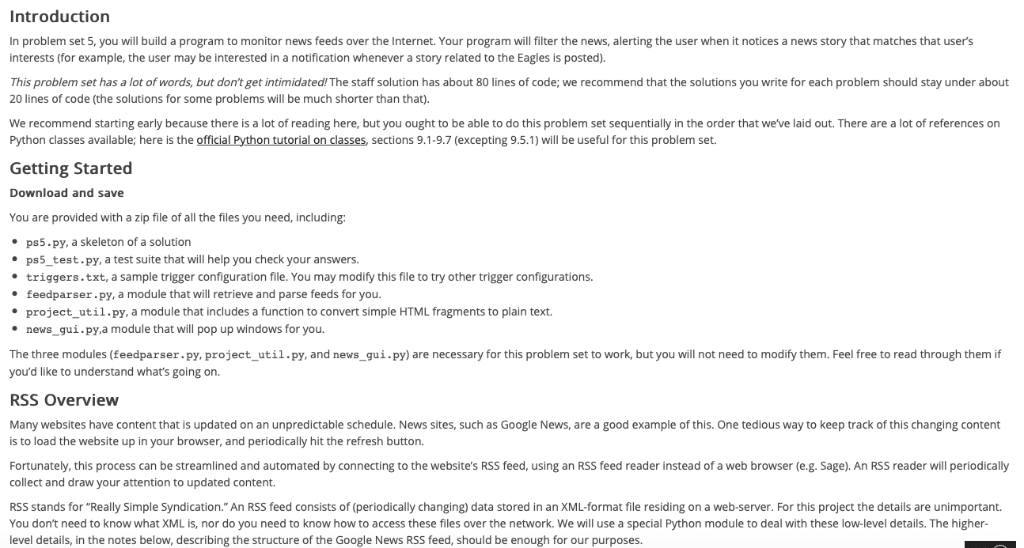
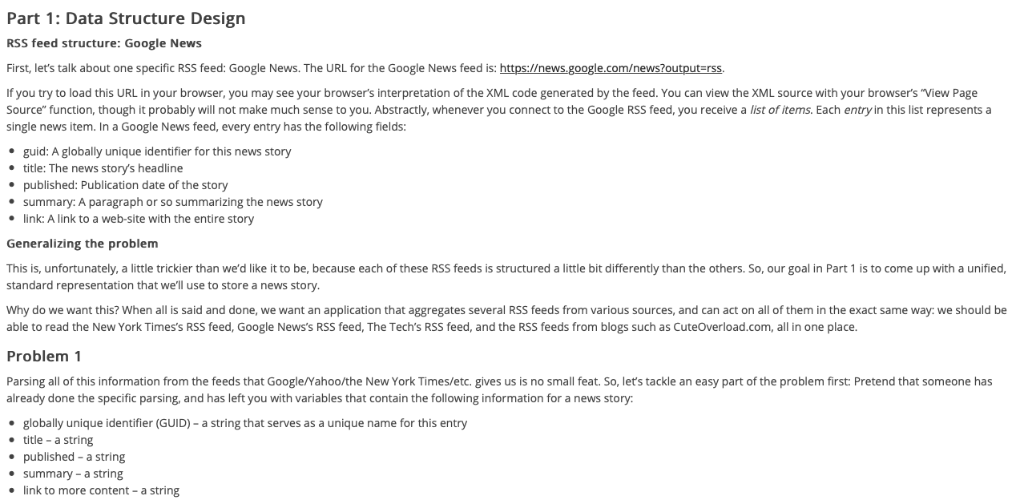
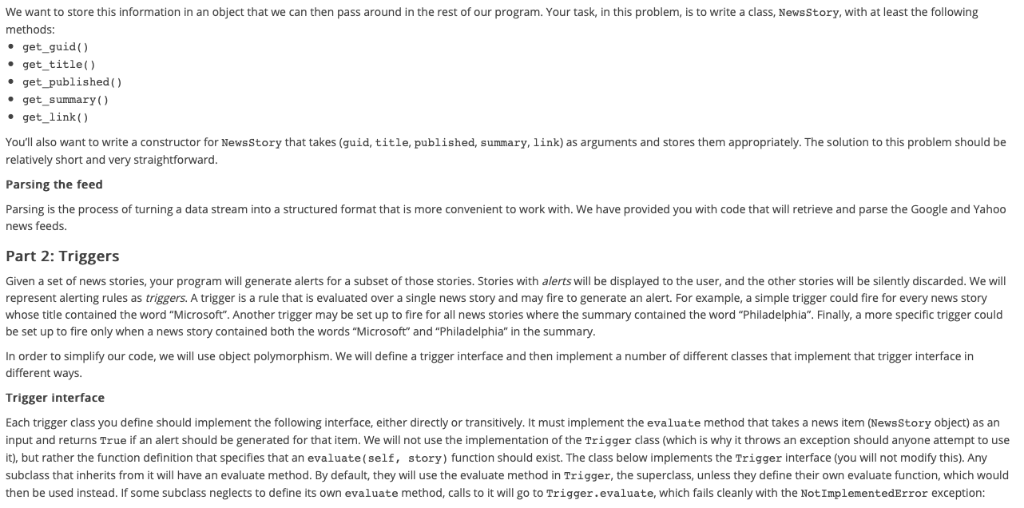
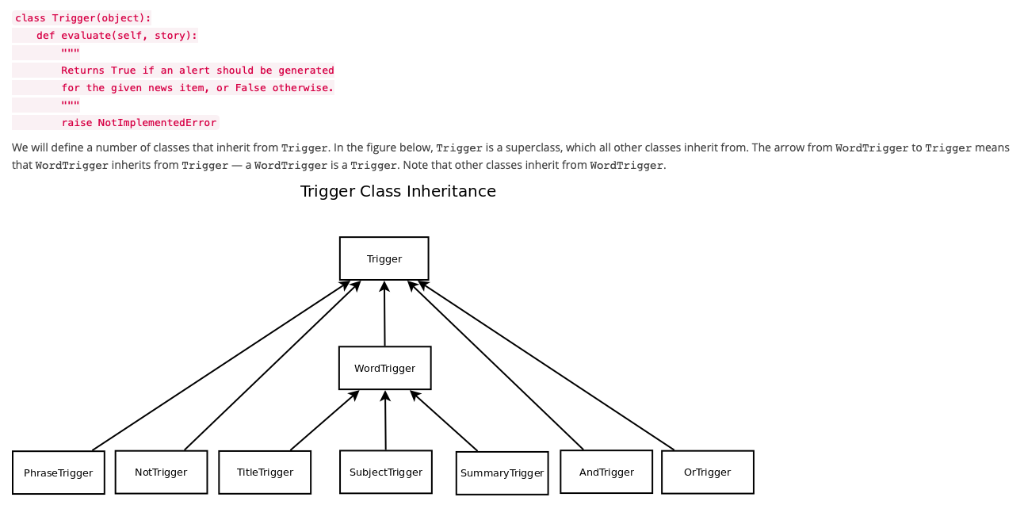
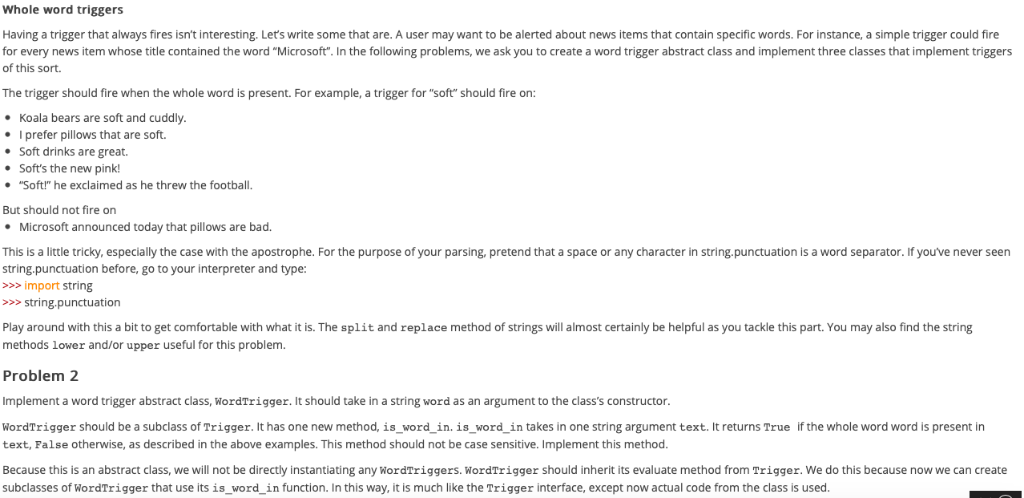
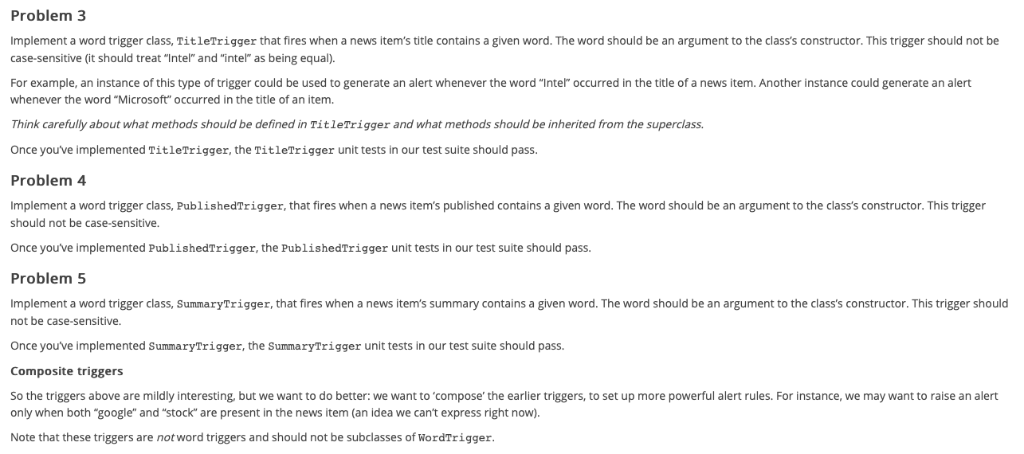
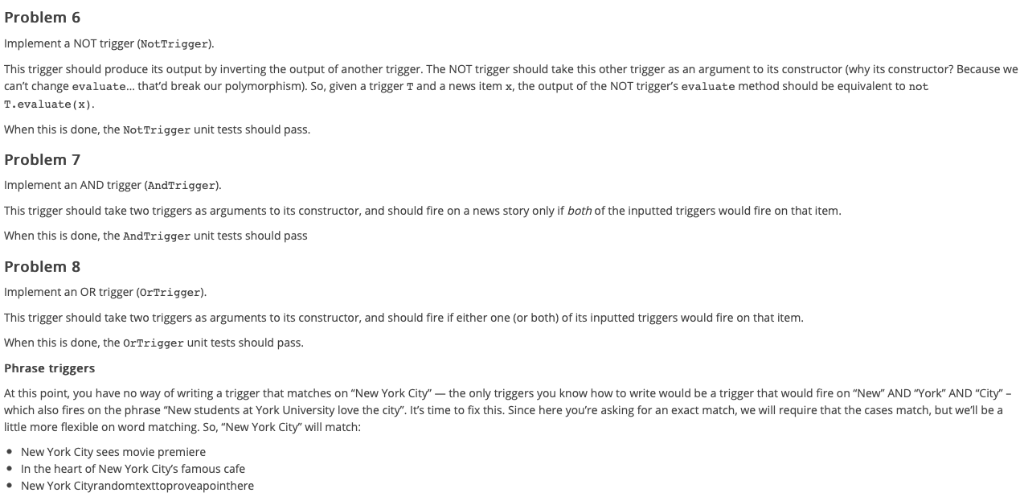
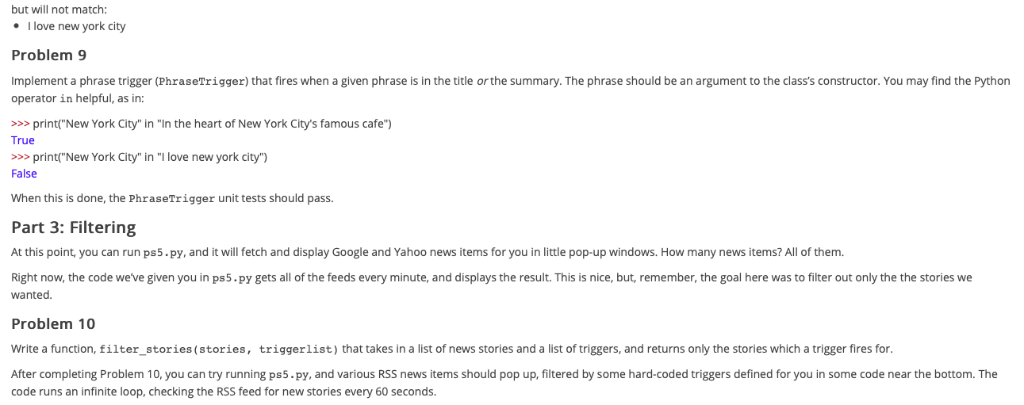
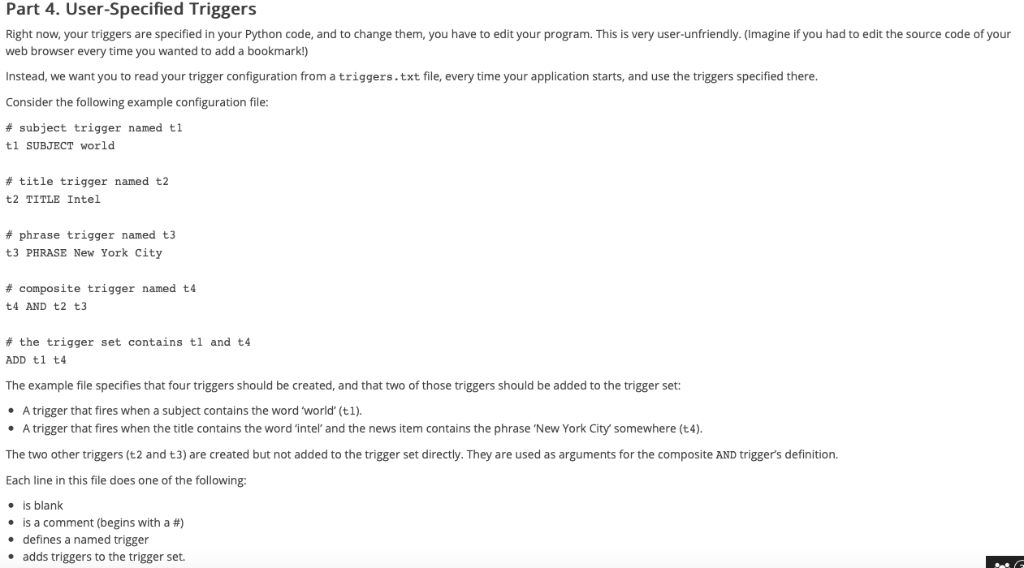
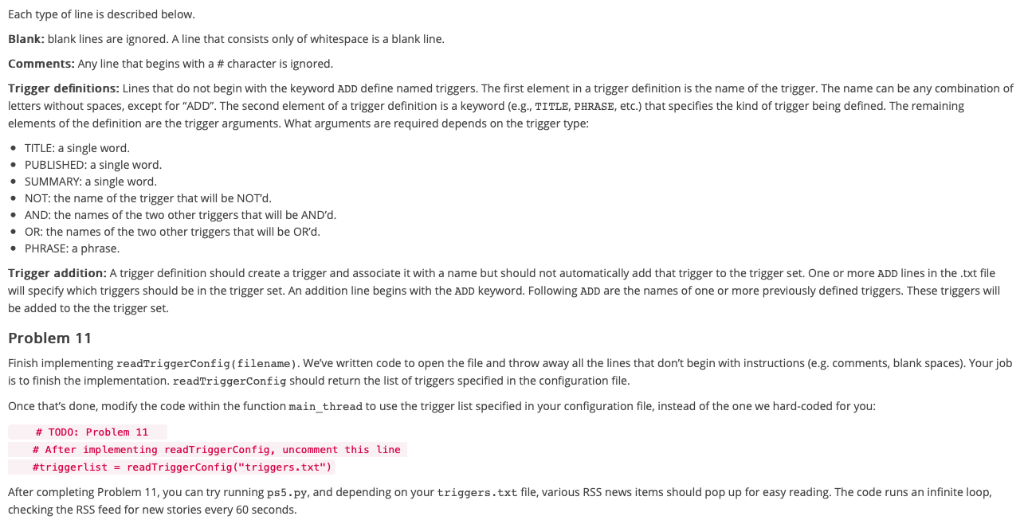
Introduction In problem set 5, you will build a program to monitor news feeds over the Internet. Your program will filter the news, alerting the user when it notices a news story that matches that users interests (for example, the user may be interested in a notification whenever a story related to the Eagles is posted). This problem set has a lot of words, but don't get intimidated/ The staff solution has about 80 lines of code; we recommend that the solutions you write for each problem should stay under about 20 lines of code (the solutions for some problems will be much shorter than that) We recommend starting early because there is a lot of reading here, but you ought to be able to do this problem set sequentially in the order that we've laid out. There are a lot of references on Python classes available; here is the official Python tutorial on classes, sections 9.1-9.7 (excepting 9.5.1) will be useful for this problem set. Getting Started Download and save You are provided with a zip file of all the files you need, including ps5.py, a skeleton of a solution ps5_test.py, a test suite that will help you check your answers. triggers.txt, a sample trigger configuration file. You may modify this file to try other trigger configurations. * feedparser.py, a module that will retrieve and parse feeds for you. project_util.py, a module that includes a function to convert simple HTML fragments to plain text. news_gui.py,a module that will pop up windows for you. The three modules (feedparser.py, project_util.py, and news_gui.py) are necessary for this problem set to work, but you will not need to modify them. Feel free to read through them if you'd like to understand what's going on. RSS Overview Many websites have content that is updated on an unpredictable schedule. News sites, such as Google News, are a good example of this. One tedious way to keep track of this changing content is to load the website up in your browser, and periodically hit the refresh button. Fortunately, this process can be streamlined and automated by connecting to the website's RSS feed, using an RSS feed reader instead of a web browser (e.g. Sage). An RSS reader will periodically collect and draw your attention to updated content. RSS stands for "Really Simple Syndication." An RSS feed consists of (periodically changing) data stored in an XML-format file residing on a web-server. For this project the details are unimportant. You don't need to know what XML is, nor do you need to know how to access these files over the network. We will use a special Python module to deal with these low-level details. The higher- level details, in the notes below, describing the structure of the Google News RSS feed, should be enough for our purposes. Part 1: Data Structure Design RSS feed structure: Google News First, let's talk about one specific RSS feed: Google News. The URL for the Google News feed is: https:/ews.google.comews?outputerss If you try to load this URL in your browser, you may see your browsers interpretation of the XML code generated by the feed. You can view the XML source with your browsers "View Page Source" function, though it probably will not make much sense to you. Abstractly, whenever you connect to the Google RSS feed, you receive a list of items. Each entry in this list represents a single news item. In a Google News feed, every entry has the following fields: guid: A globally unique identifier for this news story title: The news story's headline e published: Publication date of the story summary: A paragraph or so summarizing the news story link: A link to a web-site with the entire story Generalizing the problem This is, unfortunately, a little trickier than we'd like it to be, because each of these RSS feeds is structured a little bit differently than the others. So, our goal in Part 1 is to come up with a unified standard representation that we'll use to store a news story Why do we want this? When all is said and done, we want an application that aggregates several RSS feeds from various sources, and can act on all of them in the exact same way: we should be able to read the New York Times's RSS feed, Google News's RSS feed, The Tech's RSS feed, and the RSS feeds from blogs such as CuteOverload.com, all in one place. Problem 1 Parsing all of this information from the feeds that GoogleNahoo/the New York Times/etc. gives us is no small feat. So, let's tackle an easy part of the problem first: Pretend that someone has already done the specific parsing, and has left you with variables that contain the following information for a news story globally unique identifier (GUID) -a string that serves as a unique name for this entry e title -a string published-a string summary-a string link to more content- a string We want to store this information in an object that we can then pass around in the rest of our program. Your task, in this problem, is to write a class, NewsStory, with at least the following methods: - get_guid() get title get published() get summary() * get_link() You'll also want to write a constructor for NewsStory that takes (guid, title, published, summary, link) as arguments and stores them appropriately. The solution to this problem should be relatively short and very straightforward Parsing the feed Parsing is the process of turning a data stream into a structured format that is more convenient to work with. We have provided you with code that will retrieve and parse the Google and Yahoo news feeds. Part 2: Triggers Given a set of news stories, your program will generate alerts for a subset of those stories. Stories with alerts will be displayed to the user, and the other stories will be silently discarded. We will represent alerting rules as triggers. A trigger is a rule that is evaluated over a single news story and may fire to generate an alert. For example, a simple trigger could fire for every news story whose title contained the word "Microsoft". Another trigger may be set up to fire for all news stories where the summary contained the word "Philadelphia". Finally, a more specific trigger could be set up to fire only when a news story contained both the words "Microsoft" and "Philadelphia" in the summary In order to simplify our code, we will use object polymorphism. We will define a trigger interface and then implement a number of different classes that implement that trigger interface in different ways Trigger interface Each trigger class you define should implement the following interface, either directly or transitively. It must implement the evaluate method that takes a news item (NewsStory object) as an input and returns True if an alert should be generated for that item. We will not use the implementation of the Trigger class (which is why it throws an exception should anyone attempt to use it), but rather the function definition that specifies that an evaluate(self, story) function should exist. The class below implements the Trigger interface (you will not modify this). Any subclass that inherits from it will have an evaluate method. By default, they will use the evaluate method in Trigger, the superclass, unless they define their own evaluate function, which would then be used instead. If some subclass neglects to define its own evaluate method, calls to it will go to Trigger.evaluate, which fails cleanly with the NotImplementedError exception: class Trigger(object): def evaluate(self, story): Returns True if an alert should be generated for the given news item, or False otherwise. raise NotImplementedError We will define a number of classes that inherit from Trigger. In the figure below, Trigger is a superclass, which all other classes inherit from. The arrow from WordTrigger to Trigger means that WordTrigger inherits from Trigger-a WordTrigger is a Trigger. Note that other classes inherit from WordTrigger Trigger Class Inheritance Trigger WordTrigger PhraseTrigger NotTrigger TitleTrigger Subjectrigger Summary Trigge AndTrigger OrTrigger Whole word triggers Having a trigger that always fires isn't interesting. Let's write some that are. A user may want to be alerted about news items that contain specific words. For instance, a simple trigger could fire for every news item whose title contained the word "Microsoft". In the following problems, we ask you to create a word trigger abstract class and implement three classes that implement triggers of this sort. The trigger should fire when the whole word is present. For example, a trigger for "soft" should fire on Koala bears are soft and cuddly I prefer pillows that are soft. e .Soft drinks are great. Soft's the new pink! ."Soft!" he exclaimed as he threw the football But should not fire on Microsoft announced today that pillows are bad. This is a little tricky, especially the case with the apostrophe. For the purpose of your parsing, pretend that a space or any character in string.punctuation is a word separator. If youve never seen string punctuation before, go to your interpreter and type: >>>import string string.punctuation Play around with this a bit to get comfortable with what it is. The split and replace method of strings will almost certainly be helpful as you tackle this part. You may also find the string methods lower and/or upper useful for this problem. Problem 2 Implement a word trigger abstract class, WordTrigger. It should take in a string word as an argument to the class's constructor WordTrigger should be a subclass of Trigger. It has one new method, is_word in. is_word in takes in one string argument text. It returns True if the whole word word is present in text, False otherwise, as described in the above examples. This method should not be case sensitive. Implement this method Because this is an abstract class, we will not be directly instantiating any WordTriggers. WordTrigger should inherit its evaluate method from Trigger. We do this because now we can create subclasses of WordTrigger that use its is_word_in function. In this way, it is much like the Trigger interface, except now actual code from the class is used. Problem 3 Implement a word trigger class, TitleTrigger that fires when a news item's title contains a given word. The word should be an argument to the class's constructor. This trigger should not be case-sensitive (it should treat "Intel and "intel" as being equal). For example, an instance of this type of trigger could be used to generate an alert whenever the word "Intel occurred in the title of a news item. Another instance could generate an alert whenever the word "Microsoft occurred in the title of an item. Think carefully about what methods should be defined in TitleTrigger and what methods should be inherited from the superclass. Once you've implemented TitleTrigger, the TitleTrigger unit tests in our test suite should pass. Problem 4 Implement a word trigger class, PublishedTrigger, that fires when a news item's published contains a given word. The word should be an argument to the class's constructor. This trigger should not be case-sensitive. Once you've implemented PublishedTrigger, the PublishedTrigger unit tests in our test suite should pass. Problem 5 mplement a word trigger class, SummaryTrigger, that fires when a news item's summary contains a given word. The word should be an argument to the class's constructor. This trigger should not be case-sensitive Once you've implemented SummaryTrigger, the SummaryTrigger unit tests in our test suite should pass. Composite triggers So the triggers above are mildly interesting, but we want to do better: we want to compose' the earlier triggers, to set up more powerful alert rules. For instance, we may want to raise an alert only when both "google" and "stock" are present in the news item (an idea we can't express right now) Note that these triggers are notword triggers and should not be subclasses of WordTrigger Problem 6 Implement a NOT trigger (NotTrigger). This trigger should produce its output by inverting the output of another trigger. The NOT trigger should take this other trigger as an argument to its constructor (why its constructor? Because we cant change evaluate... .that'd break our polymorphism). So, given a trigger T and a news item x, the output of the NOT trigger's evaluate method should be equivalent to not T.evaluate(x). When this is done, the NotTrigger unit tests should pass Problem 7 Implement an AND trigger (AndTrigger) This trigger should take two triggers as arguments to its constructor, and should fire on a news story only if both of the inputted triggers would fire on that item When this is done, the AndTrigger unit tests should pass Problem 8 Implement an OR trigger (OrTrigger). This trigger should take two triggers as arguments to its constructor, and should fire if either one (or both) of its inputted triggers would fire on that item. When this is done, the OrTrigger unit tests should pass. Phrase triggers At this point, you have no way of writing a trigger that matches on "New York City"-the only triggers you know how to write would be a trigger that would fire on "New" AND "York" AND "City which also fires on the phrase "New students at York University love the city". It's time to fix this. Since here you're asking for an exact match, we will require that the cases match, but we'll be a little more flexible on word matching. So, "New York City will match: New York City sees movie premiere In the heart of New York City's famous cafe New York Cityrandomtexttoproveapointhere but will not match: 1 love new york city Problem 9 Implement a phrase trigger (PhraseTrigger) that fires when a given phrase is in the title or the summary. The phrase should be an argument to the class's constructor. You may find the Python operator in helpful, as in: >>print("New York City" in "In the heart of New York City's famous cafe") True printfNew York City" in "I love new york city") False When this is done, the PhraseTrigger unit tests should pass. Part 3: Filtering At this point, you can run ps5.py, and it will fetch and display Google and Yahoo news items for you in little pop-up windows. How many news items? All of them. Right now, the code we've given you in ps5.py gets all of the feeds every minute, and displays the result. This is nice, but, remember, the goal here was to filter out only the the stories we wanted. Problem 10 Write a function, filter_stories(stories, triggerlist) that takes in a list of news stories and a list of triggers, and returns only the stories which a trigger fires for After completing Problem 10, you can try running ps5.py, and various RSS news items should pop up, filtered by some hard-coded triggers defined for you in some code near the bottom. The code runs an infinite loop, checking the RSS feed for new stories every 60 seconds Part 4. User-Specified Triggers Right now, your triggers are specified in your Python code, and to change them, you have to edit your program. This is very user-unfriendly. (Imagine if you had to edit the source code of your web browser every time you wanted to add a bookmark!) Instead, we want you to read your trigger configuration from a triggers.txt file, every time your application starts, and use the triggers specified there. Consider the following example configuration file: # subject trigger named t1 t1 SUBJECT world # title trigger named t2 t2 TITLE Intel # phrase trigger named t3 t3 PHRASE New York City # composite trigger named t4 t4 AND t2 t3 the trigger set contains t1 and t4 ADD t1 t4 The example file specifies that four triggers should be created, and that two of those triggers should be added to the trigger set: . A trigger that fires when a subject contains the word 'world (tl) A trigger that fires when the title contains the word 'intel' and the news item contains the phrase 'New York City somewhere (t4) The two other triggers (t2 and t3) are created but not added to the trigger set directly. They are used as arguments for the composite AND trigger's definition Each line in this file does one of the following is blank . is a comment (begins with a #) . defines a named trigger e adds triggers to the trigger set Introduction In problem set 5, you will build a program to monitor news feeds over the Internet. Your program will filter the news, alerting the user when it notices a news story that matches that users interests (for example, the user may be interested in a notification whenever a story related to the Eagles is posted). This problem set has a lot of words, but don't get intimidated/ The staff solution has about 80 lines of code; we recommend that the solutions you write for each problem should stay under about 20 lines of code (the solutions for some problems will be much shorter than that) We recommend starting early because there is a lot of reading here, but you ought to be able to do this problem set sequentially in the order that we've laid out. There are a lot of references on Python classes available; here is the official Python tutorial on classes, sections 9.1-9.7 (excepting 9.5.1) will be useful for this problem set. Getting Started Download and save You are provided with a zip file of all the files you need, including ps5.py, a skeleton of a solution ps5_test.py, a test suite that will help you check your answers. triggers.txt, a sample trigger configuration file. You may modify this file to try other trigger configurations. * feedparser.py, a module that will retrieve and parse feeds for you. project_util.py, a module that includes a function to convert simple HTML fragments to plain text. news_gui.py,a module that will pop up windows for you. The three modules (feedparser.py, project_util.py, and news_gui.py) are necessary for this problem set to work, but you will not need to modify them. Feel free to read through them if you'd like to understand what's going on. RSS Overview Many websites have content that is updated on an unpredictable schedule. News sites, such as Google News, are a good example of this. One tedious way to keep track of this changing content is to load the website up in your browser, and periodically hit the refresh button. Fortunately, this process can be streamlined and automated by connecting to the website's RSS feed, using an RSS feed reader instead of a web browser (e.g. Sage). An RSS reader will periodically collect and draw your attention to updated content. RSS stands for "Really Simple Syndication." An RSS feed consists of (periodically changing) data stored in an XML-format file residing on a web-server. For this project the details are unimportant. You don't need to know what XML is, nor do you need to know how to access these files over the network. We will use a special Python module to deal with these low-level details. The higher- level details, in the notes below, describing the structure of the Google News RSS feed, should be enough for our purposes. Part 1: Data Structure Design RSS feed structure: Google News First, let's talk about one specific RSS feed: Google News. The URL for the Google News feed is: https:/ews.google.comews?outputerss If you try to load this URL in your browser, you may see your browsers interpretation of the XML code generated by the feed. You can view the XML source with your browsers "View Page Source" function, though it probably will not make much sense to you. Abstractly, whenever you connect to the Google RSS feed, you receive a list of items. Each entry in this list represents a single news item. In a Google News feed, every entry has the following fields: guid: A globally unique identifier for this news story title: The news story's headline e published: Publication date of the story summary: A paragraph or so summarizing the news story link: A link to a web-site with the entire story Generalizing the problem This is, unfortunately, a little trickier than we'd like it to be, because each of these RSS feeds is structured a little bit differently than the others. So, our goal in Part 1 is to come up with a unified standard representation that we'll use to store a news story Why do we want this? When all is said and done, we want an application that aggregates several RSS feeds from various sources, and can act on all of them in the exact same way: we should be able to read the New York Times's RSS feed, Google News's RSS feed, The Tech's RSS feed, and the RSS feeds from blogs such as CuteOverload.com, all in one place. Problem 1 Parsing all of this information from the feeds that GoogleNahoo/the New York Times/etc. gives us is no small feat. So, let's tackle an easy part of the problem first: Pretend that someone has already done the specific parsing, and has left you with variables that contain the following information for a news story globally unique identifier (GUID) -a string that serves as a unique name for this entry e title -a string published-a string summary-a string link to more content- a string We want to store this information in an object that we can then pass around in the rest of our program. Your task, in this problem, is to write a class, NewsStory, with at least the following methods: - get_guid() get title get published() get summary() * get_link() You'll also want to write a constructor for NewsStory that takes (guid, title, published, summary, link) as arguments and stores them appropriately. The solution to this problem should be relatively short and very straightforward Parsing the feed Parsing is the process of turning a data stream into a structured format that is more convenient to work with. We have provided you with code that will retrieve and parse the Google and Yahoo news feeds. Part 2: Triggers Given a set of news stories, your program will generate alerts for a subset of those stories. Stories with alerts will be displayed to the user, and the other stories will be silently discarded. We will represent alerting rules as triggers. A trigger is a rule that is evaluated over a single news story and may fire to generate an alert. For example, a simple trigger could fire for every news story whose title contained the word "Microsoft". Another trigger may be set up to fire for all news stories where the summary contained the word "Philadelphia". Finally, a more specific trigger could be set up to fire only when a news story contained both the words "Microsoft" and "Philadelphia" in the summary In order to simplify our code, we will use object polymorphism. We will define a trigger interface and then implement a number of different classes that implement that trigger interface in different ways Trigger interface Each trigger class you define should implement the following interface, either directly or transitively. It must implement the evaluate method that takes a news item (NewsStory object) as an input and returns True if an alert should be generated for that item. We will not use the implementation of the Trigger class (which is why it throws an exception should anyone attempt to use it), but rather the function definition that specifies that an evaluate(self, story) function should exist. The class below implements the Trigger interface (you will not modify this). Any subclass that inherits from it will have an evaluate method. By default, they will use the evaluate method in Trigger, the superclass, unless they define their own evaluate function, which would then be used instead. If some subclass neglects to define its own evaluate method, calls to it will go to Trigger.evaluate, which fails cleanly with the NotImplementedError exception: class Trigger(object): def evaluate(self, story): Returns True if an alert should be generated for the given news item, or False otherwise. raise NotImplementedError We will define a number of classes that inherit from Trigger. In the figure below, Trigger is a superclass, which all other classes inherit from. The arrow from WordTrigger to Trigger means that WordTrigger inherits from Trigger-a WordTrigger is a Trigger. Note that other classes inherit from WordTrigger Trigger Class Inheritance Trigger WordTrigger PhraseTrigger NotTrigger TitleTrigger Subjectrigger Summary Trigge AndTrigger OrTrigger Whole word triggers Having a trigger that always fires isn't interesting. Let's write some that are. A user may want to be alerted about news items that contain specific words. For instance, a simple trigger could fire for every news item whose title contained the word "Microsoft". In the following problems, we ask you to create a word trigger abstract class and implement three classes that implement triggers of this sort. The trigger should fire when the whole word is present. For example, a trigger for "soft" should fire on Koala bears are soft and cuddly I prefer pillows that are soft. e .Soft drinks are great. Soft's the new pink! ."Soft!" he exclaimed as he threw the football But should not fire on Microsoft announced today that pillows are bad. This is a little tricky, especially the case with the apostrophe. For the purpose of your parsing, pretend that a space or any character in string.punctuation is a word separator. If youve never seen string punctuation before, go to your interpreter and type: >>>import string string.punctuation Play around with this a bit to get comfortable with what it is. The split and replace method of strings will almost certainly be helpful as you tackle this part. You may also find the string methods lower and/or upper useful for this problem. Problem 2 Implement a word trigger abstract class, WordTrigger. It should take in a string word as an argument to the class's constructor WordTrigger should be a subclass of Trigger. It has one new method, is_word in. is_word in takes in one string argument text. It returns True if the whole word word is present in text, False otherwise, as described in the above examples. This method should not be case sensitive. Implement this method Because this is an abstract class, we will not be directly instantiating any WordTriggers. WordTrigger should inherit its evaluate method from Trigger. We do this because now we can create subclasses of WordTrigger that use its is_word_in function. In this way, it is much like the Trigger interface, except now actual code from the class is used. Problem 3 Implement a word trigger class, TitleTrigger that fires when a news item's title contains a given word. The word should be an argument to the class's constructor. This trigger should not be case-sensitive (it should treat "Intel and "intel" as being equal). For example, an instance of this type of trigger could be used to generate an alert whenever the word "Intel occurred in the title of a news item. Another instance could generate an alert whenever the word "Microsoft occurred in the title of an item. Think carefully about what methods should be defined in TitleTrigger and what methods should be inherited from the superclass. Once you've implemented TitleTrigger, the TitleTrigger unit tests in our test suite should pass. Problem 4 Implement a word trigger class, PublishedTrigger, that fires when a news item's published contains a given word. The word should be an argument to the class's constructor. This trigger should not be case-sensitive. Once you've implemented PublishedTrigger, the PublishedTrigger unit tests in our test suite should pass. Problem 5 mplement a word trigger class, SummaryTrigger, that fires when a news item's summary contains a given word. The word should be an argument to the class's constructor. This trigger should not be case-sensitive Once you've implemented SummaryTrigger, the SummaryTrigger unit tests in our test suite should pass. Composite triggers So the triggers above are mildly interesting, but we want to do better: we want to compose' the earlier triggers, to set up more powerful alert rules. For instance, we may want to raise an alert only when both "google" and "stock" are present in the news item (an idea we can't express right now) Note that these triggers are notword triggers and should not be subclasses of WordTrigger Problem 6 Implement a NOT trigger (NotTrigger). This trigger should produce its output by inverting the output of another trigger. The NOT trigger should take this other trigger as an argument to its constructor (why its constructor? Because we cant change evaluate... .that'd break our polymorphism). So, given a trigger T and a news item x, the output of the NOT trigger's evaluate method should be equivalent to not T.evaluate(x). When this is done, the NotTrigger unit tests should pass Problem 7 Implement an AND trigger (AndTrigger) This trigger should take two triggers as arguments to its constructor, and should fire on a news story only if both of the inputted triggers would fire on that item When this is done, the AndTrigger unit tests should pass Problem 8 Implement an OR trigger (OrTrigger). This trigger should take two triggers as arguments to its constructor, and should fire if either one (or both) of its inputted triggers would fire on that item. When this is done, the OrTrigger unit tests should pass. Phrase triggers At this point, you have no way of writing a trigger that matches on "New York City"-the only triggers you know how to write would be a trigger that would fire on "New" AND "York" AND "City which also fires on the phrase "New students at York University love the city". It's time to fix this. Since here you're asking for an exact match, we will require that the cases match, but we'll be a little more flexible on word matching. So, "New York City will match: New York City sees movie premiere In the heart of New York City's famous cafe New York Cityrandomtexttoproveapointhere but will not match: 1 love new york city Problem 9 Implement a phrase trigger (PhraseTrigger) that fires when a given phrase is in the title or the summary. The phrase should be an argument to the class's constructor. You may find the Python operator in helpful, as in: >>print("New York City" in "In the heart of New York City's famous cafe") True printfNew York City" in "I love new york city") False When this is done, the PhraseTrigger unit tests should pass. Part 3: Filtering At this point, you can run ps5.py, and it will fetch and display Google and Yahoo news items for you in little pop-up windows. How many news items? All of them. Right now, the code we've given you in ps5.py gets all of the feeds every minute, and displays the result. This is nice, but, remember, the goal here was to filter out only the the stories we wanted. Problem 10 Write a function, filter_stories(stories, triggerlist) that takes in a list of news stories and a list of triggers, and returns only the stories which a trigger fires for After completing Problem 10, you can try running ps5.py, and various RSS news items should pop up, filtered by some hard-coded triggers defined for you in some code near the bottom. The code runs an infinite loop, checking the RSS feed for new stories every 60 seconds Part 4. User-Specified Triggers Right now, your triggers are specified in your Python code, and to change them, you have to edit your program. This is very user-unfriendly. (Imagine if you had to edit the source code of your web browser every time you wanted to add a bookmark!) Instead, we want you to read your trigger configuration from a triggers.txt file, every time your application starts, and use the triggers specified there. Consider the following example configuration file: # subject trigger named t1 t1 SUBJECT world # title trigger named t2 t2 TITLE Intel # phrase trigger named t3 t3 PHRASE New York City # composite trigger named t4 t4 AND t2 t3 the trigger set contains t1 and t4 ADD t1 t4 The example file specifies that four triggers should be created, and that two of those triggers should be added to the trigger set: . A trigger that fires when a subject contains the word 'world (tl) A trigger that fires when the title contains the word 'intel' and the news item contains the phrase 'New York City somewhere (t4) The two other triggers (t2 and t3) are created but not added to the trigger set directly. They are used as arguments for the composite AND trigger's definition Each line in this file does one of the following is blank . is a comment (begins with a #) . defines a named trigger e adds triggers to the trigger set
















